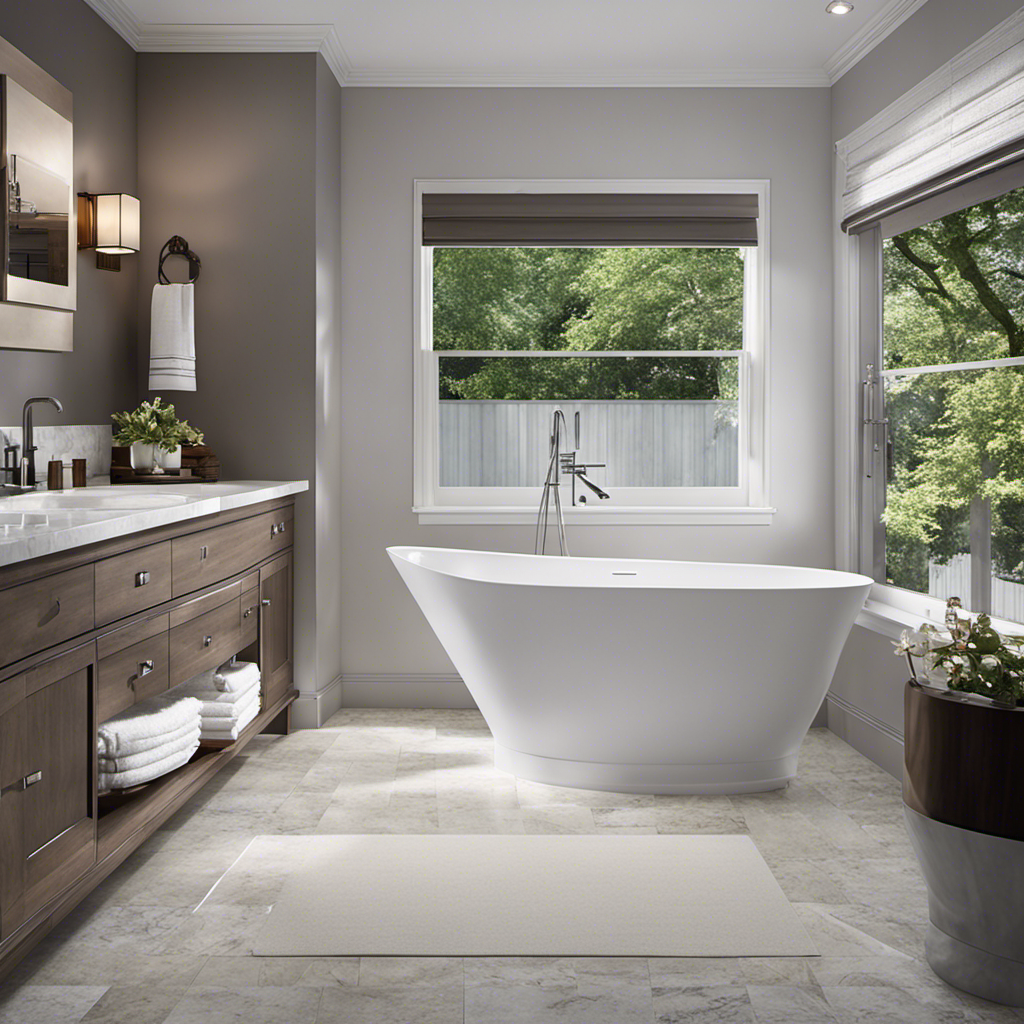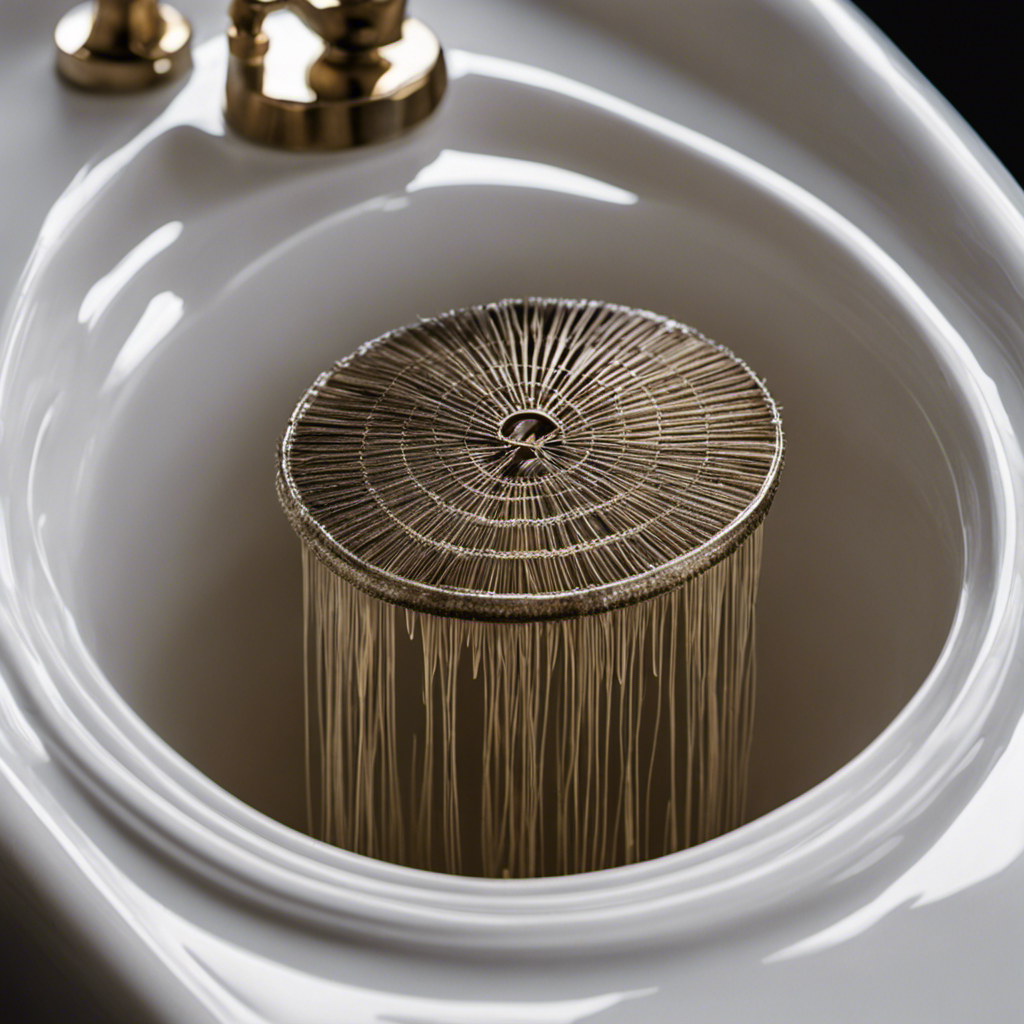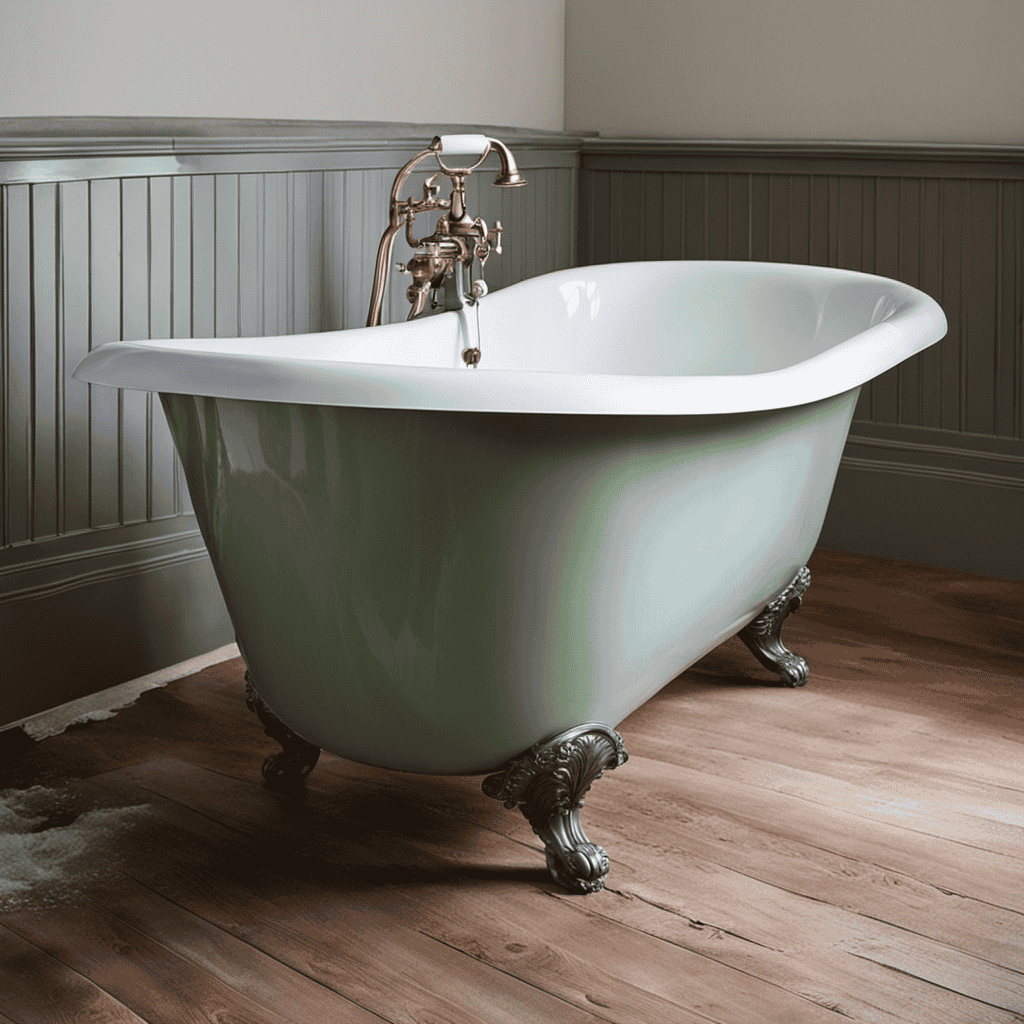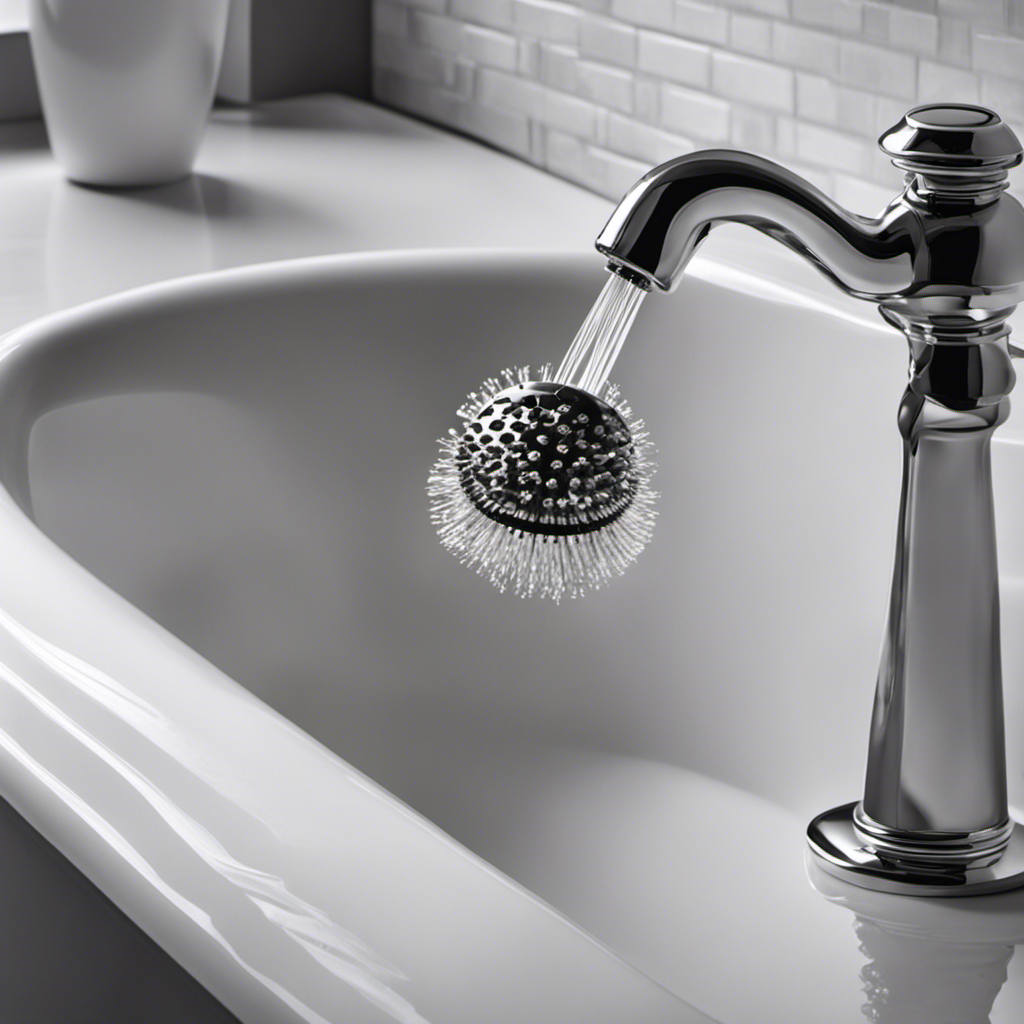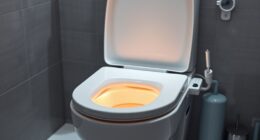Do you ever feel like you’re swimming in a sea of information when it comes to choosing a bathtub? Well, fear not, because we’re here to help you navigate the depths of bathtub dimensions.
In this article, we will dive into the world of standard bathtubs and explore just how big they really are. So, grab your snorkel and let’s explore the precise measurements and common sizes of these aquatic wonderlands for your bathroom.
Key Takeaways
- Standard bathtub dimensions typically range from 60 to 72 inches in length.
- Common materials used for bathtubs are acrylic, fiberglass, and porcelain enamel.
- Acrylic tubs are lightweight, durable, and easy to clean.
- Fiberglass tubs are lightweight but may not be as durable as acrylic.
Dimensions of a Standard Bathtub
A standard bathtub’s dimensions typically range from 60 to 72 inches in length.
When it comes to bathtub materials, you have several options to choose from. The most common materials used for bathtubs are acrylic, fiberglass, and porcelain enamel.
Acrylic tubs are lightweight, durable, and easy to clean. Fiberglass tubs are also lightweight but may not be as durable as acrylic. Porcelain enamel tubs are heavier, more expensive, but have a classic and elegant look.
When it comes to bathtub installation, it is important to consider the size of your bathroom and the location of plumbing fixtures. Make sure to measure the space accurately and consult with a professional to ensure proper installation.
Average Size of a Bathtub
When it comes to choosing a bathtub, understanding the common dimensions and ideal size can help you make an informed decision.
The common bathtub dimensions typically range from 60 to 72 inches in length, 30 to 32 inches in width, and 14 to 20 inches in depth.
However, the ideal bathtub size for you may depend on factors such as your body size, bathroom space, and personal preferences.
Common Bathtub Dimensions
You’ll commonly find bathtubs with dimensions ranging from 60 to 72 inches in length. These standard sizes are designed to accommodate most bathrooms and provide a comfortable bathing experience.
When it comes to bathtub materials, there are several options available, each with its own set of advantages and considerations. Some popular choices include:
-
Acrylic: Lightweight and durable, acrylic bathtubs are easy to clean and maintain. They also retain heat well, keeping your bathwater warm for longer periods.
-
Cast Iron: Known for their durability and longevity, cast iron bathtubs are heavy and solid. They provide excellent heat retention and are resistant to scratches and stains.
-
Fiberglass: Affordable and lightweight, fiberglass bathtubs are easy to install and repair. However, they may not be as durable as acrylic or cast iron options.
When it comes to bathtub installation, it’s important to consider factors such as plumbing requirements, space availability, and access to the bathroom. Professional installation is recommended to ensure proper fitting and functionality.
Ideal Bathtub Size
To find the ideal size for your bathtub, take into account the dimensions of your bathroom and the level of comfort you desire.
Standard bathtub materials include acrylic, cast iron, and fiberglass. Acrylic is lightweight, durable, and offers a variety of design options. Cast iron is heavy and provides excellent heat retention, but may require additional structural support. Fiberglass is affordable and easy to install, but it may not be as durable as acrylic or cast iron.
When considering bathtub design options, think about whether you prefer a built-in or freestanding tub, the shape of the tub (rectangular, oval, or corner), and the presence of features such as whirlpool jets or a soaking depth. These factors will help you determine the best size and style of bathtub for your needs, ensuring a comfortable and enjoyable bathing experience.
Now, let’s move on to standard bathtub measurements.
Standard Bathtub Measurements
When it comes to choosing the right bathtub for your bathroom, it’s essential to consider the common bathtub sizes, dimensions, and variations available in the market.
Understanding these factors will help you make an informed decision and ensure that the bathtub fits perfectly in your space.
Common Bathtub Sizes
The most common bathtub sizes range from 5 to 6 feet in length. When considering the size of a bathtub, it’s important to take into account the available space in your bathroom and your personal preferences.
Here are a few key points to consider:
-
Bathtub Materials: Bathtubs can be made from various materials such as acrylic, fiberglass, cast iron, and porcelain. Each material has its own advantages and disadvantages in terms of durability, maintenance, and aesthetics.
-
Bathtub Installation: Installing a bathtub involves several steps, including measuring the space, preparing the plumbing, and securing the tub in place. It is important to follow proper installation guidelines to ensure a secure and functional bathtub.
-
Other Considerations: In addition to size, you may want to consider the shape of the bathtub, the style of the bathroom, and any additional features like whirlpool jets or built-in armrests.
Dimensions and Variations
One important consideration when selecting a bathtub is the available space in your bathroom. To help you understand the variations in bathtub designs and the bathtub size considerations, let’s take a closer look at the dimensions of different types of bathtubs.
| Type of Bathtub | Dimensions |
|---|---|
| Standard | 60" x 30" |
| Alcove | 60" x 32" |
| Freestanding | 67" x 31" |
| Corner | 60" x 60" |
| Clawfoot | 60" x 30" |
As you can see from the table above, there are variations in the dimensions of different bathtub types. These variations allow you to choose a bathtub that fits perfectly into your bathroom space. When choosing the right size, you should consider not only the dimensions of the bathtub but also the layout of your bathroom and your personal preferences. By carefully considering these factors, you can ensure that your bathtub will fit seamlessly into your bathroom and provide you with a comfortable bathing experience.
Choosing the Right Size
To choose the right size for your new tub, consider the dimensions and layout of your bathroom, as well as your personal preferences. When it comes to bathtub materials, there are various options available, each with its own advantages and price range.
Here are some factors to consider:
- Acrylic: A popular choice due to its durability, affordability, and ease of maintenance.
- Cast Iron: Known for its strength and heat retention, but it can be heavy and expensive.
- Fiberglass: Lightweight and cost-effective, but not as durable as other materials.
In terms of price range, bathtubs can vary greatly depending on factors such as material, brand, and additional features. Basic models can start as low as $200, while more luxurious options can go upwards of $5,000.
Consider these factors and your budget when selecting the right size and material for your new bathtub.
Typical Bathtub Dimensions
Typical bathtub dimensions vary depending on the manufacturer and style. When it comes to choosing the right size for your bathroom, it is important to consider the available space and your personal preferences.
The most common dimensions for a standard bathtub are 60 inches in length, 30 inches in width, and 14 to 20 inches in depth. However, there are variations in size and shape, such as corner tubs or freestanding tubs, which can offer different dimensions.
In terms of materials, bathtubs are commonly made from acrylic, fiberglass, or porcelain-enamel coated cast iron. The installation process typically involves placing the bathtub in an alcove or against the wall and connecting the plumbing fixtures.
It is recommended to consult with a professional for proper installation and to ensure that the dimensions are suitable for your specific bathroom space.
Common Sizes for Bathtubs
When it comes to choosing the ideal bathtub dimensions for your bathroom, there are a few key points to consider.
First, you’ll want to ensure that the bathtub is spacious enough for comfortable soaking.
Second, it’s important to take into account the available space in your bathroom and opt for space-saving bathtub options if necessary.
Ideal Bathtub Dimensions
The ideal bathtub dimensions for most bathrooms are around 60 inches in length and 30 inches in width. This size allows for a comfortable bathing experience while still fitting within the constraints of a typical bathroom space.
When considering bathtub design, it is important to take into account not only the dimensions but also the shape and style. Some popular bathtub designs include freestanding tubs, alcove tubs, and corner tubs.
Additionally, bathtub materials play a significant role in the overall design and functionality. Common materials include acrylic, fiberglass, cast iron, and porcelain. Each material has its own advantages and disadvantages in terms of durability, maintenance, and aesthetic appeal.
Ultimately, the ideal bathtub dimensions and materials will depend on your personal preferences and the specific requirements of your bathroom.
Space-Saving Bathtub Options
One popular option for saving space in a bathroom is to install a compact, corner bathtub. These space-saving bathtub designs are ideal for smaller bathrooms or when you want to maximize floor space.
Compact bathtub options come in various shapes and sizes, allowing you to find the perfect fit for your bathroom layout. Corner bathtubs are specifically designed to fit snugly into the corner of a room, providing a practical solution for optimizing space. These tubs often feature unique designs, such as triangular or curved shapes, to make the most of the available space.
Standard Bathtub Width and Length
To determine the width and length of a standard bathtub, measure the available space in your bathroom and consult the manufacturer’s specifications. This will ensure that you choose a bathtub that fits perfectly into your bathroom layout.
When considering the size of a standard bathtub, keep in mind that the average width is around 30-32 inches, while the average length is around 60-72 inches. Additionally, it’s important to note that the depth of a standard bathtub can vary, but it typically ranges from 14-20 inches.
When measuring your bathroom space, take into account any existing fixtures or obstacles that may affect the positioning of the bathtub. By carefully considering these factors and consulting the manufacturer’s specifications, you can ensure that your chosen standard bathtub will fit seamlessly into your bathroom and provide you with a comfortable bathing experience.
Sizing a Bathtub for Your Bathroom
When determining the perfect size for your bathtub, be sure to measure the available space in your bathroom and consult the manufacturer’s specifications. Sizing a bathtub can present some challenges, especially if you have limited space or unusual bathroom layouts.
It is important to consider how you will fit the bathtub into your bathroom without compromising functionality or aesthetics. Additionally, you will need to consider the material options for your bathtub. Common materials include acrylic, fiberglass, cast iron, and porcelain enamel.
Each material has its own advantages and disadvantages in terms of durability, maintenance, and cost. By considering the sizing challenges and bathtub material options, you can make an informed decision when choosing the right size bathtub for your bathroom.
Choosing the Right Size Bathtub
Determining the perfect size for your bathtub requires careful consideration of available space and consultation of manufacturer’s specifications. When choosing the right size bathtub, it’s important to keep in mind the dimensions of your bathroom and the needs of your household.
Here are some key factors to consider:
-
Available space: Measure the area where your bathtub will be installed to ensure it fits properly.
-
User comfort: Consider the height, width, and depth of the bathtub to ensure it provides enough room for comfortable bathing.
-
Bathtub materials: Different materials, such as acrylic, cast iron, or fiberglass, can affect the size and weight of the bathtub.
By taking these factors into account, you can select a bathtub that not only fits your bathroom but also meets your comfort and style preferences.
Don’t forget to consult the manufacturer’s specifications for detailed information on installation requirements and guidelines.
Standard Bathtub Capacity
Consider the amount of water you’ll need for a comfortable bath and choose a bathtub with a capacity that suits your needs.
When it comes to standard bathtub capacity, it is important to understand the materials used and the weight capacity of the tub. Most standard bathtubs are made from materials such as acrylic, fiberglass, or cast iron. These materials are chosen for their durability and ability to hold water without leaking.
In terms of weight capacity, standard bathtubs can typically hold between 300 to 500 pounds. This weight capacity is important to consider, especially if you plan on sharing the tub or if you have any mobility concerns.
Understanding Bathtub Size Options
Now that you understand the capacity of a standard bathtub, let’s dive into the various size options available to you. When considering the size of a bathtub, there are several factors to keep in mind, especially if you have a small bathroom.
Here are some bathtub size considerations:
-
Length: Measure the available space in your bathroom to determine the maximum length that can fit comfortably.
-
Width: Consider the width of the bathtub, ensuring it fits within the available space without obstructing other fixtures.
-
Depth: The depth of the bathtub is crucial for relaxation and comfort. Consider how deep you want your bathtub to be.
For small bathrooms, there are specific bathtub dimensions that can maximize space utilization. Look for compact bathtubs with dimensions designed for small bathrooms, such as corner bathtubs or alcove tubs.
Frequently Asked Questions
What Are the Different Types of Bathtubs Available on the Market?
Different types of bathtubs available on the market include acrylic, cast iron, and fiberglass. They come in various shapes, such as rectangular, oval, and corner. Consider the materials and shapes that suit your preferences when choosing a bathtub.
Can I Install a Standard Bathtub in a Small Bathroom?
When renovating a small bathroom, installing a standard bathtub may not be feasible. However, there are alternative options like corner or freestanding tubs that can save space while still providing a relaxing bathing experience.
Are There Any Regulations or Building Codes That Dictate the Size of a Bathtub?
Bathtub regulations and building codes dictate the dimensions of a bathtub. These regulations ensure that the bathtub meets safety standards and can accommodate the average person comfortably.
How Do I Measure My Bathroom to Determine the Right Size Bathtub for It?
To determine the right size bathtub for your bathroom, start by measuring the available space. Consider the length, width, and height of the area. This will help you determine the maximum dimensions for your bathtub.
Are There Any Additional Factors to Consider When Choosing the Right Size Bathtub for My Needs?
When choosing the right size bathtub for your needs, factors like bathroom layout and usage should be considered. Assess how the tub will fit in your space and if it meets your bathing requirements.
Conclusion
So there you have it, now you know how big a standard bathtub is. Whether you’re renovating your bathroom or just looking to upgrade your current tub, understanding the dimensions and sizes available is crucial.
By choosing the right size bathtub for your space, you can ensure a comfortable and enjoyable bathing experience. Remember to consider not only the length and width, but also the depth and capacity of the tub.
With these factors in mind, you’ll be well on your way to creating the perfect bathroom oasis.
